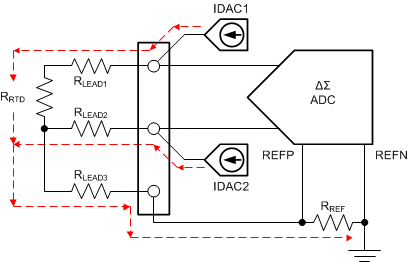SBAA275A June 2018 – March 2023 ADS1120 , ADS112C04 , ADS112U04 , ADS1147 , ADS1148 , ADS114S06 , ADS114S06B , ADS114S08 , ADS114S08B , ADS1220 , ADS122C04 , ADS122U04 , ADS1247 , ADS1248 , ADS124S06 , ADS124S08 , ADS125H02 , ADS1260 , ADS1261 , ADS1262 , ADS1263
- A Basic Guide to RTD Measurements
- 1RTD Overview
-
2RTD Measurement Circuits
- 2.1 Two-Wire RTD Measurement With Low-Side Reference
- 2.2 Two-Wire RTD Measurement With High-Side Reference
- 2.3 Three-Wire RTD Measurement, Low-Side Reference
- 2.4 Three-Wire RTD Measurement, Low-Side Reference, One IDAC Current Source
- 2.5 Three-Wire RTD Measurement, High-Side Reference
- 2.6 Four-Wire RTD Measurement, Low-Side Reference
- 2.7 Two Series Two-Wire RTD Measurements, Low-Side Reference
- 2.8 Two Series Four-Wire RTD Measurements
- 2.9 Multiple Two-Wire RTD Measurements
- 2.10 Multiple Three-Wire RTD Measurements
- 2.11 Multiple Four-Wire RTD Measurements in Parallel
- 2.12 Universal RTD Measurement Interface With Low-Side Reference
- 2.13 Universal RTD Measurement Interface With High-Side Reference
- 3Summary
- 4Revision History
1.4.1 Lead Resistance Cancellation
In Figure 1-5, the lead resistances of a three-wire RTD are shown and a second excitation current source is added, labeled IDAC2.
 Figure 1-5 Example of Lead Wire Resistance Cancellation
Figure 1-5 Example of Lead Wire Resistance CancellationWith a single excitation current source, RLEAD1 adds an error to the measurement. By adding IDAC2, the second excitation current source is used to cancel out the error in the lead wire resistance. When adding the lead resistances and the second current source, the equation becomes:
If the lead resistances match and the excitation currents match, then RLEAD1 = RLEAD2 and IIDAC1 = IIDAC2. The lead wire resistances cancel out so that Equation 6 reduces to the result in Equation 7 maintaining a ratiometric measurement.
RLEAD3 is not part of the measurement, because it is not in the input measurement path or in the reference input path.